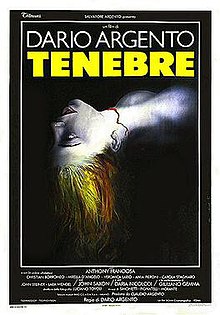
Back Tenebre Catalan Tenebre Welsh Tenebrae (Film) German Tenebre: Ο Παρανοϊκός Δολοφόνος Greek Tenebre EML Tenebrae (película) Spanish ظلمت Persian Pelkoa ei voi paeta Finnish Ténèbres (film) French Tebras (filme) Galician
| Tenebrae | |
|---|---|
 Italian theatrical release poster by Renato Casaro | |
| Italian | Tenebre |
| Directed by | Dario Argento |
| Written by | Dario Argento |
| Produced by | Claudio Argento |
| Starring | |
| Cinematography | Luciano Tovoli |
| Edited by | Franco Fraticelli |
| Music by | |
Production company | Sigma Cinematografica |
| Distributed by | Titanus[1] |
Release date |
|
Running time | 101 minutes |
| Country | Italy |
Tenebrae (lit. '"darkness"', also known as Tenebre) is a 1982 Italian giallo[2][3][4][5] film written and directed by Dario Argento. The film stars Anthony Franciosa as American author Peter Neal, who – while in Rome promoting his latest murder-mystery novel – becomes embroiled in the search for a serial killer who may have been inspired to kill by his novel. John Saxon and Daria Nicolodi co-star as Neal's agent and assistant respectively, while Giuliano Gemma and Carola Stagnaro appear as detectives investigating the murders. John Steiner, Veronica Lario, and Mirella D'Angelo also feature in minor roles. The film has been described as exploring themes of dualism and sexual aberration, and has strong metafictional elements; some commentators consider Tenebrae to be a direct reaction by Argento to criticism of his previous work, most especially his depictions of murders of women.
After Argento had experimented with pure supernatural horror with 1977's Suspiria and 1980's Inferno, Tenebrae represented the filmmaker's return to the giallo subgenre, which he had helped popularize in the 1970s. Argento was inspired by a series of incidents which saw an obsessed fan telephone the director to criticize him for the damaging psychological effects of his previous work. The telephone calls culminated in death threats towards Argento, who channelled the experience into the writing of Tenebrae. The director also wanted to explore the senselessness of killings he had seen and heard about while staying in Los Angeles in 1980, and his feeling at the time that true horror came from those who wanted "to kill for nothing".[6]
Shot on location in Rome and at Elios Studios, Tenebrae utilized mostly modern-looking locations and sets, allowing Argento to realize his vision that the film reflects a near-future with a diminished population; the director filmed none of the historical landmarks that usually featured in films set in Rome. Employing director of photography Luciano Tovoli, Argento also intended that the film simulate the stark, realistic lighting featured in television police shows at the time; production designer Giuseppe Bassan created supporting environments that were cold and austere, with sharp angles and modernistic spaces. Several former members of Italian rock band Goblin provided Tenebrae's music, a synth-heavy score inspired by rock and disco music.
Tenebrae was a modest success in Italy; it reached theatres with little controversy after Argento made cuts to one of the most violent scenes. However, in the United Kingdom, it was added to the infamous list of "video nasties" and banned from sale until 1999. The film's theatrical distribution in the United States was delayed until 1984 when it was released in a heavily censored version under the title Unsane, which received a mostly negative critical reception. The original version later became widely available for reappraisal, and has come to be considered one of Argento's best films by many fans and critics.
- ^ "Tenebrae (1982)". Archivio del Cinema Italiano On-Line.
- ^ Tenebre (1982) - Dario Argento | Synopsis, Characteristics, Moods, Themes and Related | AllMovie, retrieved 7 June 2023
- ^ "How Dario Argento's Classic 'Tenebrae' Was Inspired By His Stalker". Collider. 12 August 2022. Retrieved 7 June 2023.
- ^ "The Quietus | Film | Film Features | 30 Years On: Tenebrae Revisited". The Quietus. Retrieved 7 June 2023.
- ^ Cite error: The named reference
c9was invoked but never defined (see the help page). - ^ Jones, Alan (27 June 2011). Dario Argento's Tenebrae (DVD booklet). Arrow Films.